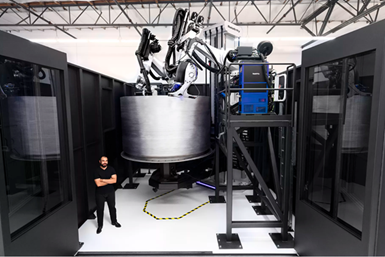Clean TeQ, Relativity Space Collaborate on Scandium Aluminium Alloys for 3D Printing of Rockets
Project to develop scandium-aluminium alloys for 3D printing of launchers for commercial orbital launch services.

3D printing of the Terran 1 launch vehicle at Relativity’s Stargate factory.
Clean TeQ Holdings Limited is collaborating with Relativity Space Inc. to develop scandium-aluminium alloys for 3D printing of launchers for commercial orbital launch services. The two companies have also agreed to a binding Scandium Offtake Heads of Agreement for the Company to supply scandium oxide (volumes to be determined at Relativity’s election) from Clean TeQ’s Sunrise Project in New South Wales, Australia.
Clean TeQ’s technical and marketing team will work closely with Relativity on development of scandium-containing alloys for Relativity’s Stargate 3D printing process. The company says that, so far, the results are encouraging and trials are progressing.
Clean TeQ’s Sunrise Project is being developed as one of the world’s largest integrated producers of nickel sulphate and cobalt sulphate – key cathode materials for the electric vehicle battery market, according to the company. However, it also hosts one of the largest and highest grade scandium deposits ever discovered, positioning Clean TeQ to be a major supplier of low-cost scandium for production of next-generation lightweight aluminium alloys for use in a variety of industries, including aerospace, automotive and consumer products
Headquartered in Los Angeles, California, Relativity Space Inc. is a private American aerospace manufacturing company which is developing its Terran 1 (the world’s first 3D-printed space launch rocket) and Aeon engines for commercial orbital launch services.
Aerospace manufacturing has traditionally relied on large factories, fixed tooling, complex supply chains and extensive manual labor to build costly rockets comprised of more than 100,000 parts, with lead times of two years or more. Relativity has engineered and built the Stargate factory, the first aerospace platform to automate rocket manufacturing, vertically integrating intelligent robotics, software and data-driven 3D printing technology.
Incorporating the world’s largest metal 3D printers and artificial intelligence driven controls, the company says that the Stargate factory continuously optimizes production, resulting in greatly enhanced quality and time improvements, lower costs and part counts, and product designs previously not possible. Relativity has developed multiple proprietary alloys, custom designed for 3D printing to meet mission-critical performance.
Related Content
-
Will the Successes of NASA’s RAMFIRE Project Lead to an Operational Aerospike Engine?
NASA’s RAMFIRE project has additively manufactured a 36-inch diameter aerospike nozzle with complex integral coolant channels for a more efficient way to propel rockets to outer space. NASA engineers will use this as a proof of concept to inform future component designs.
-
Reusable LOX/Kerosene Engine Completes First Successful Full-System Test Flight
Galactic Energy Space Technology announced the first successful full-system test flight of its Welkin 50-ton reusable LOX/kerosene engine. To date, this is the highest thrust LOX/kerosene engine in the Chinese commercial aerospace playing field which has officially entered the engineering and manufacturing phase.
-
Supernova Creates Defense and Space Business Unit to Develop 3D Printing of Military-Grade Energetic Materials
Target applications for the new business unit include solid rocket motors which are critical components for the next-generation hypersonic platforms.













